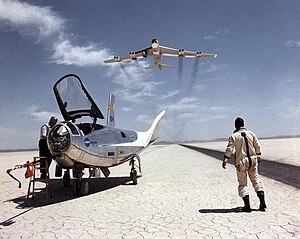HL-10
| HL-10 | |
|---|---|
 |
|
| Role | Lifting body technology demonstrator |
| Manufacturer | Northrop |
| Designer | Langley Research Center |
| First flight | 22 December 1966 |
| Retired | 17 July 1970 |
| Status | On display, NASA Armstrong Flight Research Center |
| Primary user | NASA |
| Number built | 1 |
The Northrop HL-10 was one of five American heavyweight lifting body designs flown at NASA's Flight Research Center (FRC—later Dryden Flight Research Center) in Edwards, California, from July 1966 to November 1975 to study and validate the concept of safely maneuvering and landing a low lift-over-drag vehicle designed for reentry from space. It was a NASA design and was built to evaluate "inverted airfoil" lifting body and delta (letter) planform. It currently is on display at the entrance to the Dryden Flight Research Center at Edwards Air Force Base.
Northrop Corporation built the HL-10 and Northrop M2-F2, the first two of the fleet of "heavy" lifting bodies flown by the NASA Flight Research Center. The contract for construction of the HL-10 and the M2-F2 was $1.8 million. "HL" stands for horizontal landing, and "10" refers to the tenth design studied by engineers at NASA's Langley Research Center, Hampton, Virginia. Main gear was a modified T-38 system retracted manually, and lowered by nitrogen pressure. Nose gear was modified T-39 unit, retracted manually and lowered with nitrogen pressure. Pilot Ejection System was a modified F-106 system. Silver zinc batteries provided electrical power for control system, flight instruments, radios, cockpit heat, and stability augmentation system. To assist in pre-landing flare, four throttleable hydrogen peroxide rockets provided up to 400 lbf (1.8 kN) of thrust.
...
Wikipedia
